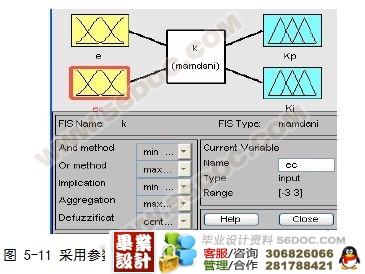温控系统的设计及仿真(MATLAB)

摘 要
温度是工业控制的主要被控参数之一,可是由于温度自身的一些特点,如惯性大,滞后现象严重,难以建立精确的数学模型等,给控制过程带来了难题。本文研究合适的控制方案对电烤箱温度进行控制,技术要求是调节时间短,超调量为零且稳态误差在±1℃内。对电烤箱这样一个被控对象进行控制,有很多方案可选。
本文分析了PID控制和模糊控制的优缺点,考虑可以把它们相互结合,实现优势互补。文中用 simulink软件对 PID 控制、模糊控制和参数模糊自整定PID 控制的控制性能和抗干扰能力分别进行了仿真研究,仿真结果表明参数模糊自整定 PID 控制能满足调节时间短、超调量为零且稳态误差在±1℃内的控制要求,且对暂态可回复性干扰、不可回复性干扰和随机干扰都有很强的抑制能力。因此本论文最终确定采用参数模糊自整定 PID 控制方案;(毕业设计 )
设计了以 AT89C52 单片机为核心的温度控制器,选用 k 型热电偶为温度传感器结合MAX6675芯片构成前向通道,同时双向晶闸管和SSR构成后向通道,由按键、LED 数码显示器及报警单元等组成人机联系电路。在进行硬件设计的同时,也设计了相应软件程序流程图。 [资料来源:www.doc163.com]
关键词:AT89C52; PID 控制;模糊控制;仿真 [资料来源:https://www.doc163.com]
ABSTRACT [资料来源:www.doc163.com]
Temperature is one of the main parameters controlled in the industrial process. But it is very difficult to control temperature well because of some characteristics of the temperature itself. For example temperature’s inertia is great, it’s time-lag is serious and it is difficult to establish accurate mathematical model of the object. This paper is to study an adapt control method to control the temperature of the electric oven, the technology demand of control method is: the regulating time must be short, the overshoot must be zero and steady-state error must be in ±1℃.For the electric oven, there are many control methods to be selected.
This paper analyses the advantages and disadvantages of the PID control and fuzzy control and comes to the method of combining them together. In the paper stimulations of PID control、fuzzy control and fuzzy self-tuning PID control are done by simulink And then the fuzzy self-tuning PID control method is selected.. because it can meet the control demands and it’s anti-interference ability is very strong.. Moreover, simulation results show that: it’s robustness is good because very good control result that the regulating time is short, the overshoot is zero and the steady-error is very little can be obtained, for first-order inertia and time-lag model.
[资料来源:http://doc163.com]
In the paper AT89S52 is used as controller, toward access is composed of K which is used as temperature sensor, and with MAX6675 .Backward access is composed of photoelectrical coupler and Solid State Relay SSR. Man-machine circuit is composed of buttons, LED and warning unit, etc. While the hardware circuit is designed, the corresponding procedure flow chart is also designed.
[资料来源:http://doc163.com]
Key words: AT89C52; PID Control; Fuzzy Control; Stimulation;
温度微机控制系统控制方案
计算机技术的发展极大地推动了工业控制系统的进步,而现代控制理论的发展,人工智能技术的深入研究,为控制系统的理论领域增加了新的内容。计算机硬件与控制软件的紧密结合必然导致新型的微机控制系统的出现。温度微机控制系统常用的控制方案有以下三类:经典控制方案、基于现代控制理论的设计方案和智能控制方案。
智能控制方案是一类无需人的干预就能够针对控制对象的状态自动地调节控制规律以实现控制目标的控制策略。它避开了建立精确的数学模型和用常规控制理论进行定量计算与分析的困难性。它实质上是一种无模型控制方案,即在不需要知道对象精确模型的情况下,通过自身的调节作用,使实际响应曲线逼近理想响应曲线。
智能控制系统有以下一些特点:
(l)智能控制系统一般具有以知识表示的非数学广义模型和以数学模型表示的混合控制过程。它适用于含有复杂性、不完全性、模糊性、不确定性和不存在己知算法的生产过程。
(2)智能控制具有信息处理和决策机构,它实际上是对人神经结构或专家决策机构的一种模仿。
(3)智能控制器具有非线性。
(4)智能控制器具有变结构的特点。
(5)智能控制器具有总体自寻优的特点。
目前快速发展的一些具体温控方案
常用的温度控制电路根据应用场合和要求的性能指标的不同,除了传统的PID控制方法,近几年来快速发展的是将模糊控制、神经网络、遗传算法等智能控制方法应用于温控系统,以及包括智能控制与PID控制相结合及这些智能控制之间的结合。具体有如下一些方法:
(1)模糊控制:
(2)遗传算法与PID的结合:
(3)模糊控制与PID的结合:
(4)神经网络与PID的结合:
(5)模糊控制、神经网络和遗传算法三者的结合: [资料来源:www.doc163.com]
本文所做的工作 [资料来源:https://www.doc163.com]
基于以上所述目前国内外的温控方法的各自特点,以及温度这一物理参数变化缓慢,大惯性和大滞后的特点,本设计考虑采用模糊控制与PID控制相结合的参数模糊自整定PID控制方法来对温度进行控制。
本文所做的工作是:对电烤箱这一控制对象,选择了纯PID控制、纯模糊控制和参数模糊自整定PID控制三种控制方案,运用Simulink软件对它们的控制性能和抗干扰能力进行了仿真研究比较,选出合乎响应速度快、超调量为零、稳态误差在±1℃内的技术要求的解决方案。另外以AT89C52单片机为核心的电烤箱温度控制系统的硬件电路设计及相应软件程序结构设计,以及与此相关的前向通道、后向通道、人机通道的设计。



[资料来源:Doc163.com]
目 录
第1章 引言 1
1.1 课题的提出及意义 1
1.2 文献综述 1
1.2.1 工业温度控制发展简介 1
1.2.2 温度微机控制系统控制方案 1
1.2.3 目前快速发展的一些具体温控方案 2
1.3 本文所做的工作 2
第2章 硬件系统 3
2.1 单片机中央控制系统 3
2.1.1 单片机简介 3
2.1.2 时钟电路 4
2.1.3 复位电路 5
2.1.4 I\O接口扩展 6
2.2 前向通道 6
2.2.1 常用形式 7
2.2.2 集成形式 7
2.3 后向通道 9
(毕业设计 )
2.3.1 双向晶闸管 9
2.3.2 固体继电器SSR 9
第3章 人机通道 10
3.1 按键电路 11
3.2 数码管显示电路 12
3.3 蜂鸣报警电路 12
第4章 PID控制 14
4.1 PID 控制理论 14
4.1.1 PID 控制概述 14
4.1.2 PID 控制的基本理论 14
4.2 模糊控制理论 16
4.2.1 模糊控制概述 16 [资料来源:http://www.doc163.com]
4.2.2 模糊控制的基本原理 16
4.3 模糊 PID 控制 17
第5章 仿真研究 19
5.1 仿真工具 19
5.2 MATLAB及仿真环境 simulink 19
5.3 仿真和优选。 19
5.3.1 控制对象模型 20
5.3.2 仿真 21
5.3.3 方案选择 26
第6章 单片机软件设计 26
6.1 主程序设计 27
6.2 热电偶测温查表子程序 27
6.3 滤波子程序 27
6.4 中断子程序 31
6.5 人-机接口程序 33
结束语 35
参考文献 36
致谢 37
附录 38
